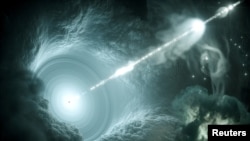Scientists have announced a new finding about the source of a high-energy neutrino, a subatomic particle detected at an observatory at the Earth's South Pole.
The study, published Thursday in the journal Science, details the work of more than 1,000 scientists who pooled their research on the tiny particles, which are able to pass through matter in a straight line — like a ghost.
The neutrino's ability to travel without deviation from its course means its source can be accurately tracked, unlike other types of subatomic particles that can be dragged off course by a magnetic field like the Earth's.
"[Neutrinos are] very clean, they have simple interactions, and that means every single neutrino interaction tells you something," said Heidi Schellman, a particle physicist at Oregon State University.
The scientists used a large observatory known as IceCube, in use since 2010, to hunt for neutrinos and try to track the source. A group of neutrinos coming from the same location over the past couple of years was determined to have emanated from a blazar, or black hole that aims a jet of radiation at Earth. The black hole is estimated to have been in a distant galaxy that destructed four billion years ago.
The blazar that is considered the source of the neutrino was named TXS 0506+056 and is believed to be the first known source of a high-energy neutrino.
The discovery could be a breakthrough for multimessenger astronomy, where scientists look at the entire electromagnetic spectrum and pool their findings, using known relationships between types of electromagnetic particles to put together a larger picture.
"It is an entirely new means for us to learn about the cosmos," Roopesh Ojha of NASA's Goddard Space Flight Center told The Washington Post.







